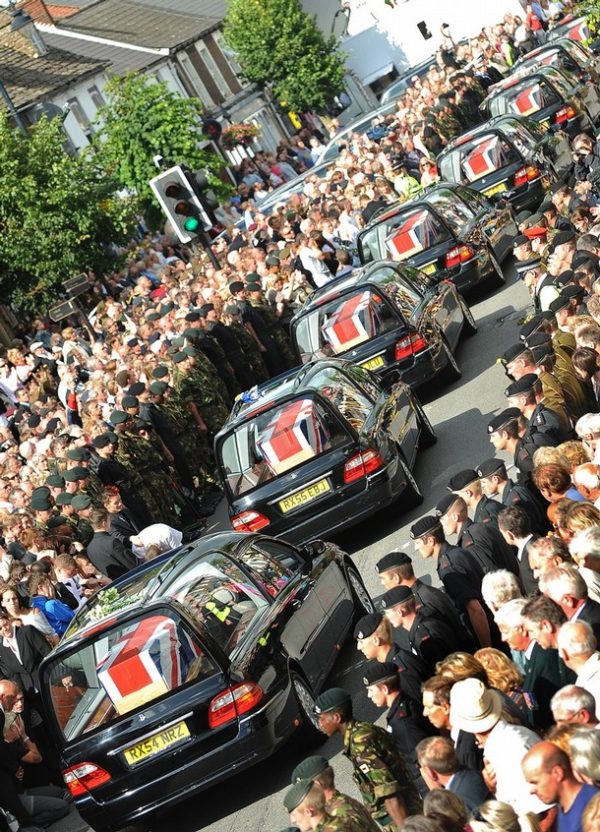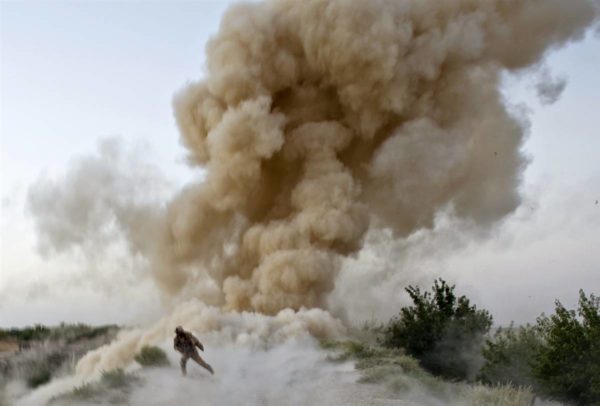Notes
Chris Hondros on "The Hurt Locker"
Given the rave reviews this film is receiving, the fact that a film can be largely responsible for the picture of a conflict people walk away with in their mind’s eye, and because Chris Hondros, having made twelve trips to Iraq in covering the war, is one of America’s most respected and highly praised photojournalists, BNN is pleased to offer this review.
I’ve been waiting for a truly great movie about the Iraq War. I know it’s still going on, but I don’t think it’s impossible to ask: Casablanca came out right in the middle of World War II in 1942, and M*A*S*H, with its Korea-as-Vietnam theme, was released in 1970. I’ve thought a lot about this, since like many journalists who have frequented Iraq I’ve often been frustrated by the public’s misunderstandings about the place, and have thought for some time that a thoughtful, tone-perfect movie could help explain to a general audience what the experience of being in Iraq was (and is) like.
The Hurt Locker, recently released to positive reviews and much acclaim, seemed like it could have been that movie. But having seen it I don’t think The Hurt Locker will do for the Iraq War what, say, Apocalypse Now or Platoon did for our understanding of Vietnam. It might be the best Iraq movie out so far, but that’s not saying much. To me The Hurt Locker fell flat–partly because the soldiers behave in implausible ways throughout, but mostly because I don’t think it offers us a coherent plot or deep character development, the stuff all great movies are made of.
The Hurt Locker tells the story of an Army bomb-defusing trio based out of Camp Victory in Baghdad on the last month of their deployment. The team is (reluctantly) led by a reckless a staff sergeant explosives expert named William James (played with indisputable talent by Jeremy Renner). His support duo is a risk-averse sergeant named J.T. Sanborn (Anthony Mackie) and a young specialist, Owen Eldridge (Brian Geraghty).
The movie gets off to a good start–the opening scene is appropriately tense, and the superficial details about the Iraq environment look just right, more so than any Iraq movie previously. The Army uniforms and Iraqi style of dress, for instance, are perfect, and the Humvees look just like they did in 2004, when the movie is set. Camp Victory, Baghdad’s largest base, looks in the movie just like it really does: a bleak gravel plain covered in soulless white barracks trailers. The physical look is fantastic.
But it isn’t long before the movie gets mired down in absurd and seemingly pointless misadventures.
Staff Sgt. James and his two comrades seem to constantly be on their own, often blithely driving their Humvee around Baghdad without additional support. One scene has them driving their Humvee completely unescorted in the desert, which is so silly I laughed aloud. That little sojourn results in the team getting ambushed (which is why you don’t go driving around in the desert by yourself in Iraq) and battling off insurgents in a grueling sniper firefight. Young specialist Eldridge, covering the teams’ flank in a terrifying battle of survival, nonetheless takes the time to leisurely ask Staff Sgt. James for permission to fire when he spots an insurgent taking aim at him from a nearby ridge (good thing Iraqis are so habitually late at everything they do).
I admit that some of that previous criticism stems from my familiarity of military procedure in Iraq, but other plot developments defy logic even if you’re not familiar with the place.
Staff Sgt. James’s chummy relationship with an Iraqi boy on base is only tenuously explored, but when he finds that the boy has been killed he implausibly removes his uniform and goes AWOL, running off alone into central Baghdad on a vigilante mission. It gets worse: James, wildly waving his pistol, bursts into an Iraqi home he suspects has some relation to the murder, only to find himself staring at an urbane, multi-lingual Iraqi man, with whom he has a confusing and remarkably calm conversation. Then the Iraqi man’s wife appears and physically beats James out of the house (which will no doubt be the favorite part of the movie to Iraqis themselves, should this get this screened in Baghdad sometime).
James then heads back to base, licking his wounds; and while the movie has James easily and unrealistically leaving Camp Victory and wandering around Baghdad alone, when he goes back he is (quite realistically) caught by screaming Army perimeter guards. The next scene has the brooding James back in his trailer; nobody mentions a court-martial, which is what certainly would have resulted from an escapade like that.
Another, much-quoted scene has the fully-suited James investigating a possible bomb in the courtyard of a school, and eventually finding a massive amount of explosives in a car’s trunk. He then removes his bomb suit to the chagrin of his comrades and announces “if I’m going to die, I’m going to die comfortable.” This is meant to indicate James’s reckless machismo, I guess; but of course if a car bomb explodes anyone standing nearby will be blown to pieces with or without protective gear on, as James himself indicates.
The reckless act here is defusing the bomb by hand in the first place, not doing it without a protective suit that will not protect. For that matter, what is the dramatic point in hand-defusing a massive car bomb when all the civilians nearby had already been evacuated, as the movie took pains to show? Why are we asked to fear the destruction of an empty school courtyard?
It’s not so much that James does all these unlikely things, but that he does them for weakly-explained reasons. Near the end of the movie the trio is summoned to investigate the scene of a deadly bomb attack in a Baghdad neighborhood. James suspects that the triggerman escaped down a nearby alley; and with an unconvincing bit of verbal patter he persuades Sanborn and Eldridge to take off with him (once again, alone) into the Baghdad night. The group separates and Eldridge is kidnapped by militants; just barely are James and Sanborn able to track them down and shoot the insurgents holding their friend, shattering Eldridge’s leg with a bullet in the process. We next see the understandably-irritated Eldridge on medical chopper, bidding a rueful goodbye to James, who seems not particularly sorry for the misadventure (maybe he’s preoccupied about his likely second court martial in as many weeks).
Oddly, the best part of the movie is its closing minutes, after James leaves Iraq for his family at home. James is in a supermarket with his wife and son and is tasked with getting breakfast cereal; finding the cereal aisle he stares mute as the seemingly infinite choices. It’s a funny, poignant moment, and it seems to me that this could have been the heart of the movie: how does one return to a life of normalcy after a year of insanity in Iraq? That’s the real question that thousands of soldiers and Marines (as well as journalists and governmental staff) have had to confront since the Iraq war began. But it will take another movie to explore this critical idea, The Hurt Locker, for all its explosions and tension, doesn’t really even try.
* * *
(originally posted 7/10/09)
Chris Hondros is an American war photographer, based in New York. He has made over a dozen trips to Iraq in six years, chronicling the war and occupation since the beginning of the conflict. His images from Iraq are published around the world and have won many international awards, including the 2006 Robert Capa Gold Medal, the highest honor in war photography. He is a senior staff photographer for Getty Images, the international photo agency.


Reactions
Comments Powered by Disqus